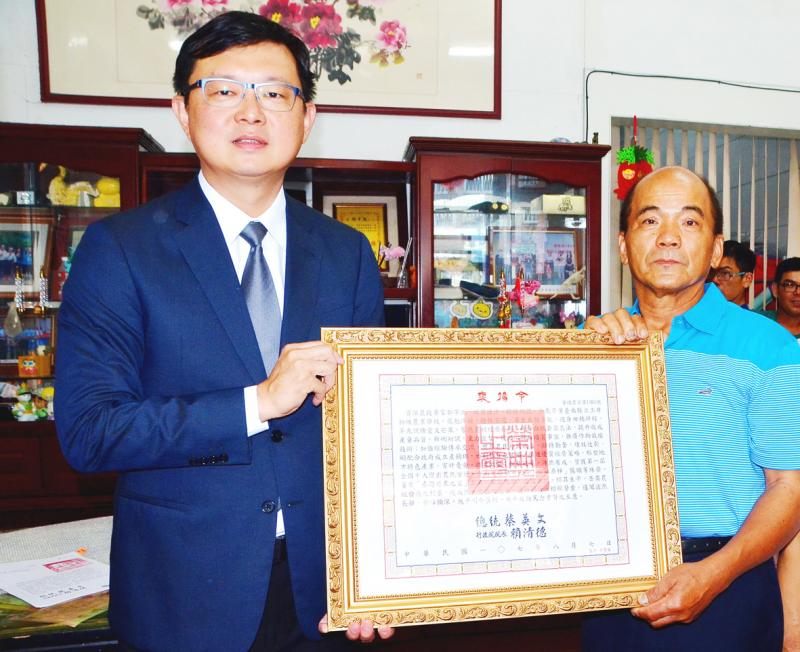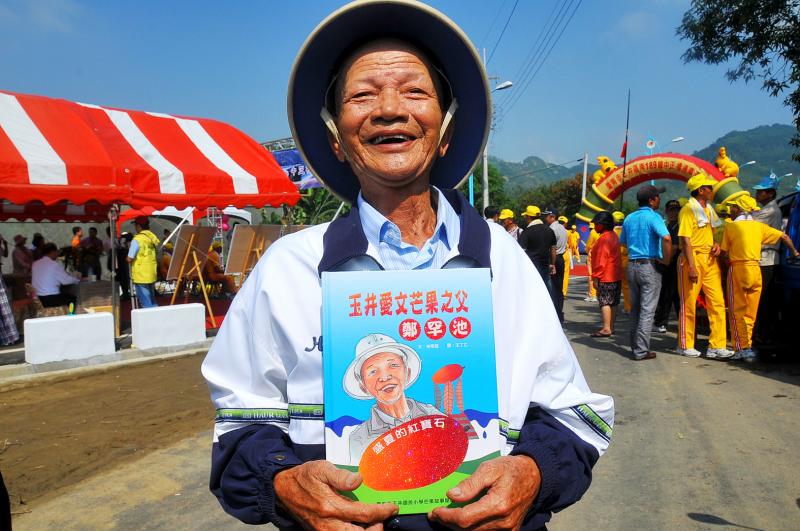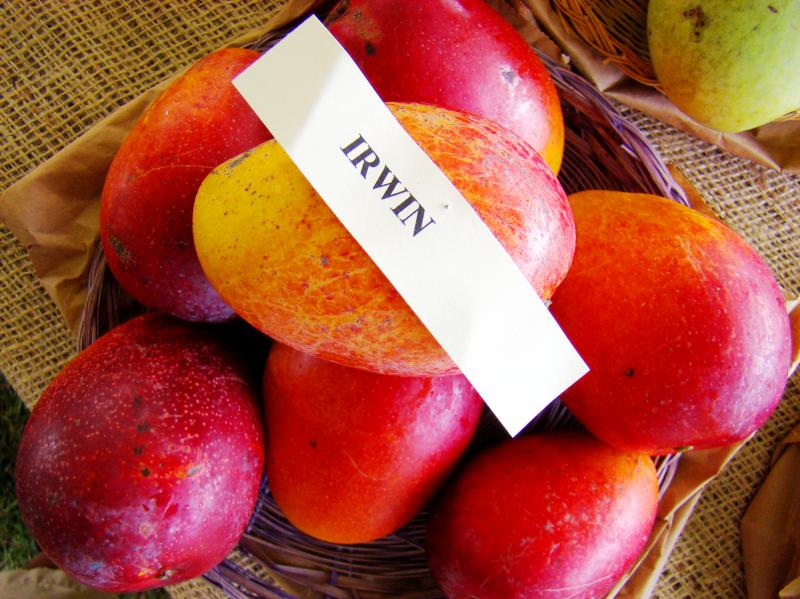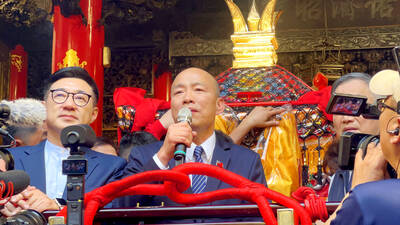May 31 to june 6
Douliuzai Village (斗六仔) was once considered the poorest settlement in Tainan’s Yujing District (玉井). The residents were often the butt of local jokes — one saying poked fun of their lack of money, yellowed faces and smelly feet.
The village’s fortunes drastically changed in the late 1960s due to the efforts of Cheng Han-chih (鄭罕池), who planted the nation’s first Irwin mango trees in 1962. By the early 1970s, everyone was growing the lucrative fruit and “Irwin mansions” sprouted up in the area. In 1973, the government established the first mango special agricultural zone in the village.

Photo: Wu Chun-feng, Taipei Times
While mangoes have been grown in Taiwan for about 400 years, the sweet, red Irwin variety introduced from the US has dominated the market in the past 50 years.
In the beginning, however, Cheng was the only farmer in Yujing willing to try planting the variety — and to his dismay, 96 of the 100 saplings he received perished during a cold front that winter. Cheng persisted and obtained another 100 the next year, and his efforts finally bore fruit in 1965.
Cheng still faced a slew of problems ranging from pest control to marketing, but he worked out the kinks and tirelessly promoted the new product to fellow farmers in his community. In 1967, the Yujing Farmers Association reported a whopping NT$300 million gross revenue (NT$2 billion today) from Irwin mangoes alone. By the 1970s, public perception had changed so much that anyone from Douliuzai was considered a wealthy person.

Photo: Liu Wan-chun, Taipei Times
Cheng died on June 1, 2018, and his status as the “Father of Taiwan’s Irwin mangoes” was cemented a year later when the Tainan City government installed a plaque on a column in front of his former residence.
MANGO HISTORY
Most sources agree that the Dutch introduced the mango to Taiwan about 400 years ago. Curiously, many official sources state the year of introduction as 1561 — but the Dutch didn’t even reach Southeast Asia until 1595, upon which it founded the Dutch East India Company (VOC) in present day Indonesia in 1602. Its colony in present-day Taiwan was established two decades later.

Photo courtesy of Wikimedia Commons
Taiwan’s first Dutch governor, Martinus Sonck, wrote to VOC headquarters in 1625, requesting them to send some horses and saplings of grape, lychee, durian and mango. This is more believable as the origin of the Dutch-introduced mango.
Ming and Qing Dynasty chronicles often state that Taiwan’s mango was introduced by the Dutch via Japan, but that’s also unlikely as mango farming didn’t begin in the southern island of Kyushu until the 1980s — also using saplings of the Irwin mango from the US. The Japanese colonial government actually tried to introduce the mango to nearby Ishigaki island from Taiwan during the 1930s, but this venture failed due to differences in climate.
The original mango is referred to as the “native mango” (土芒果) today, and it is still grown and eaten. Compared to the Irwin, however, it’s small, sour and fibrous, and is commonly made into candied or pickled products.
In 1954, Lu Chih-lin (陸之琳) of the Taiwan Agricultural Research Institute imported five types of mango from the US state of Florida. Lu grew up in an impoverished rural village in China, and after coming to Taiwan with the Chinese Nationalist Party (KMT), he put his efforts into searching for new products to improve the lives of the nation’s farmers.
After experimenting for a few years, his team deemed that the Irwin was most suited for Taiwan’s environment.
TIRELESS PROMOTION
By 1961, Lu was working for the Sino-American Joint Commission on Rural Reconstruction. The commission tasked him with promoting the Irwin mango in 11 areas in southern Taiwan, including Yujing. Cheng, who was mostly growing low-profit cassava and sugarcane, wanted to provide a better life for his children, but had no idea how to due to his lack of education.
After becoming an officer in the local farmer’s association, Cheng witnessed how farmers in other regions improved their finances through growing fruit (such as oranges in Chiayi) with government assistance. When Lu approached him regarding the Irwin mango, he said yes immediately and took home all 100 saplings allotted for Yujing. His neighbors thought he was crazy, and they seemed to be right when only four survived the cold front.
Lu rushed to the orchards and tried in his broken Hoklo (also known as Taiwanese) to convince the farmers to give it another try, but all of them refused except for Cheng, who worked closely with Lu for the next two years until they finally found success.
Problems soon arose, however, as the mango was especially susceptible to damage from the oriental fruit fly. Cheng noticed how lychee farmers in Kaohsiung used paper bags to protect their products, and he ordered mango-sized bags from a local factory. It worked, and the pest damage rate for his mangoes dropped to 5 percent.
Promoting the fruit was also a problem as locals were not used to its taste. Cheng traveled the country trying to find a buyer, and finally found his benefactor through a chance encounter with Taichung’s “Orange King,” Yeh A-mao (葉阿茂). The mangoes sold out within a few days, and soon his entire village was growing them.
In 1977, Cheng was named among the nation’s top 10 outstanding farmers. But his grandson Cheng Cheng-chin (鄭承靖) told Business Today (今日週刊) magazine in 2013 that many competitors tried to discredit his grandfather until 2009, when then-Tainan County commissioner Su Huan-chih (蘇煥智) visited Cheng and officially announced him as the “godfather of mangoes.”
Three years later, Cheng was made an honorary citizen of Tainan City. Yujing’s mangoes not only brought great economic benefit to the region, tourists also poured in to sample the delectable fruit at its source. A giant mango statue stands in the middle of a roundabout leading to the village, and mango ice shops line the streets.
Today, one of the four surviving trees from Cheng’s first attempt still stands in his grand-nephew’s yard. His sons and grandsons carry on his legacy in the orchard, proudly continuing to produce the fruit that has been nicknamed “the ruby of the summer.”
Taiwan in Time, a column about Taiwan’s history that is published every Sunday, spotlights important or interesting events around the nation that either have anniversaries this week or are tied to current events.

April 14 to April 20 In March 1947, Sising Katadrepan urged the government to drop the “high mountain people” (高山族) designation for Indigenous Taiwanese and refer to them as “Taiwan people” (台灣族). He considered the term derogatory, arguing that it made them sound like animals. The Taiwan Provincial Government agreed to stop using the term, stating that Indigenous Taiwanese suffered all sorts of discrimination and oppression under the Japanese and were forced to live in the mountains as outsiders to society. Now, under the new regime, they would be seen as equals, thus they should be henceforth

Last week, the the National Immigration Agency (NIA) told the legislature that more than 10,000 naturalized Taiwanese citizens from the People’s Republic of China (PRC) risked having their citizenship revoked if they failed to provide proof that they had renounced their Chinese household registration within the next three months. Renunciation is required under the Act Governing Relations Between the People of the Taiwan Area and the Mainland Area (臺灣地區與大陸地區人民關係條例), as amended in 2004, though it was only a legal requirement after 2000. Prior to that, it had been only an administrative requirement since the Nationality Act (國籍法) was established in

With over 80 works on display, this is Louise Bourgeois’ first solo show in Taiwan. Visitors are invited to traverse her world of love and hate, vengeance and acceptance, trauma and reconciliation. Dominating the entrance, the nine-foot-tall Crouching Spider (2003) greets visitors. The creature looms behind the glass facade, symbolic protector and gatekeeper to the intimate journey ahead. Bourgeois, best known for her giant spider sculptures, is one of the most influential artist of the twentieth century. Blending vulnerability and defiance through themes of sexuality, trauma and identity, her work reshaped the landscape of contemporary art with fearless honesty. “People are influenced by

Three big changes have transformed the landscape of Taiwan’s local patronage factions: Increasing Democratic Progressive Party (DPP) involvement, rising new factions and the Chinese Nationalist Party’s (KMT) significantly weakened control. GREEN FACTIONS It is said that “south of the Zhuoshui River (濁水溪), there is no blue-green divide,” meaning that from Yunlin County south there is no difference between KMT and DPP politicians. This is not always true, but there is more than a grain of truth to it. Traditionally, DPP factions are viewed as national entities, with their primary function to secure plum positions in the party and government. This is not unusual